







A good way to start is by running a few of the Ptolemy demos. Any user can do this, although average users are not permitted to change the demos. If you feel compelled to change a demo, you can copy it to your own directory by using cp -r (see the section below,
"Copying objects" on page 2-55). You can modify the copied version.
In any terminal window, change to the master demo directory:
cd $PTOLEMY/demo
Start the Ptolemy graphical interface:
ptiny &
Here we are starting the smallest version, which contains only a subset of Ptolemy domains. You should get three windows: a vem console window at the upper left of your screen, a palette with icons of demonstrations below that, and a message window identifying the version of Ptolemy, as shown in figure 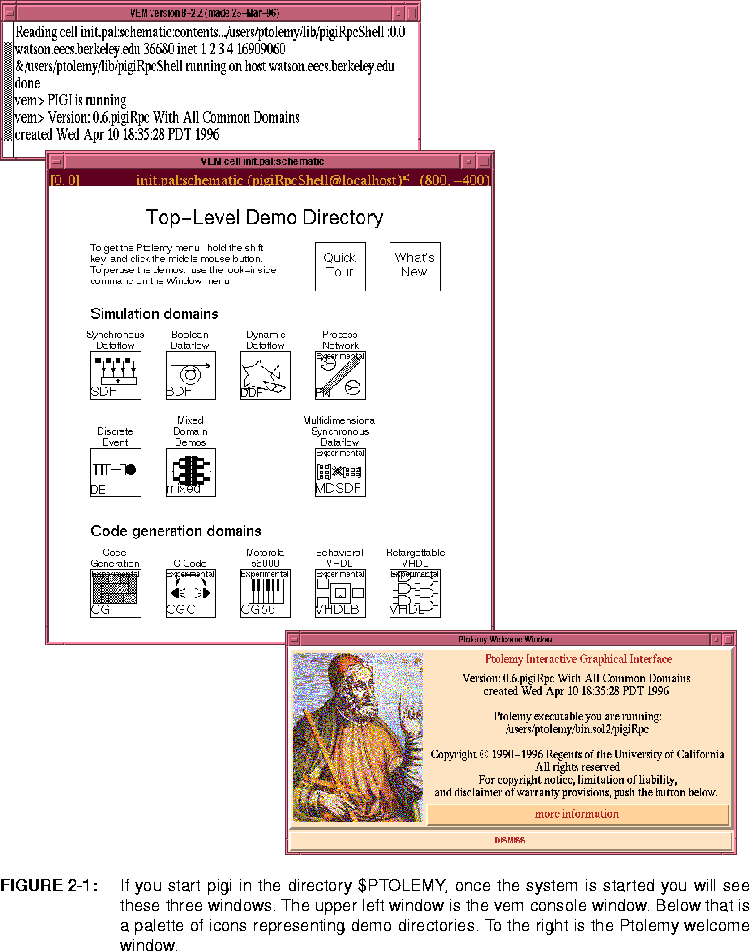 2-1. The borders on your windows may look different, since they are determined by the window manager that you use. If you have problems starting ptiny, see
"Problems starting pigi" on page 7-179. A complete list of options that you can specify on the command line is given in the section
"Command-line options" on page 2-62.
2-1. The borders on your windows may look different, since they are determined by the window manager that you use. If you have problems starting ptiny, see
"Problems starting pigi" on page 7-179. A complete list of options that you can specify on the command line is given in the section
"Command-line options" on page 2-62.
Once you get all three windows, you have started two processes: the graphical editor, vem, and a process named pigiRpc that contains the pigi code and the Ptolemy kernel. The vem window prints the textual commands corresponding to your selections with the mouse. Watching the vem window is useful in diagnosing mistakes, such as drawing a box when you meant to draw a line. The vem console window also displays debugging messages, as well as the error and warning messages that appear in popup windows.
Clicking any mouse button in the welcome window (the one with the picture of Mr. Ptolemy) will dismiss it. Clicking the left mouse button on the "more information" button will display copyright information. The remaining windows can be moved and resized using whatever mechanism your window manager supports. The windows can be closed by typing a control-d with the mouse cursor inside the window. Closing the vem console window will terminate the entire program.
For reference, a summary of the pertinent terms is given in table
2-1 on page 16.
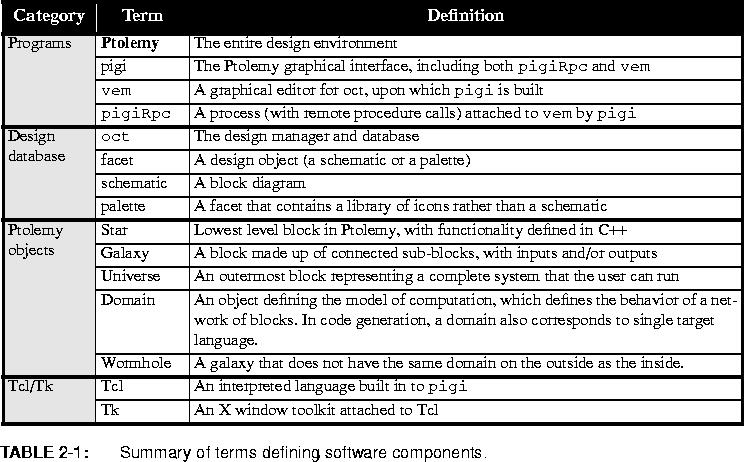 These will be discussed in more detail as we go.
These will be discussed in more detail as we go.
The palette window contains icons. Five different types of icons are used in pigi, as shown in figure
2-2
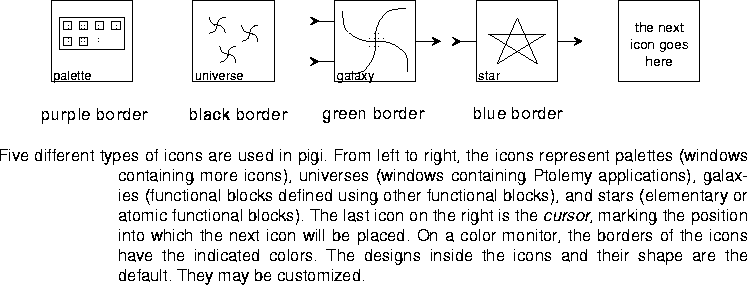 . The ones in the palette window are of the first type; they represent other palettes. If you have a color monitor, the outline on these icons is purple.
. The ones in the palette window are of the first type; they represent other palettes. If you have a color monitor, the outline on these icons is purple.
Place the mouse cursor on the icon labeled "SDF". Get the pigi command menu by holding the shift key and clicking the middle mouse button. This style of menu is called a "walking menu." Make sure you hold the shift button. The resulting command menu is shown below:
The names displayed in the left main menu are only headers. To see the individual commands under each header, you must move the mouse to the arrows at the right of the menu. The sub-menu that appears on the right contains commands. Clicking any mouse button with a command highlighted as shown on the right will execute that command. To remove the menu without executing any command, simply click a mouse button anywhere outside the menu.
Go to the "Window" sub-menu, and execute the look-inside command, as shown above on the right. A new palette will open, containing icons representing further palettes. Look inside the first of these, labeled "Basic". The icons inside contain application programs, called "universes" in Ptolemy. The two palettes you have just opened are shown in figure
2-3.
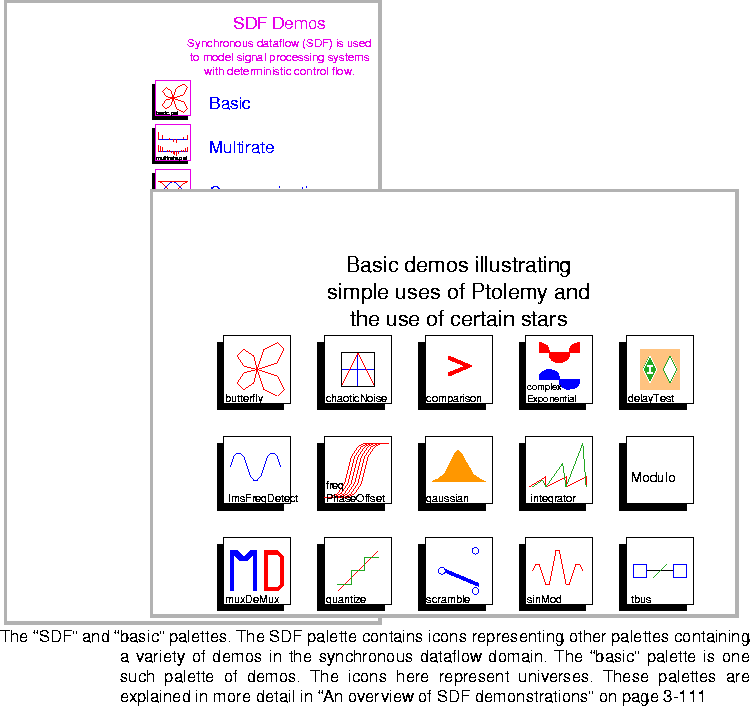 They are both explained in further detail in
"An overview of SDF demonstrations" on page 3-111.
They are both explained in further detail in
"An overview of SDF demonstrations" on page 3-111.
Note in the Ptolemy menu that the look-inside directive has an "i" next to it. This is a "single key accelerator." Without using the walking menu, you can look inside any icon by simply placing the mouse cursor and hitting the "i" key on the keyboard. The single-key accelerators are extremely useful. In time, you will find that you use the menu only for commands that have no accelerator, or for which you cannot remember the accelerator. The Ptolemy commands obtained through the above menu are summarized in table
2-2.
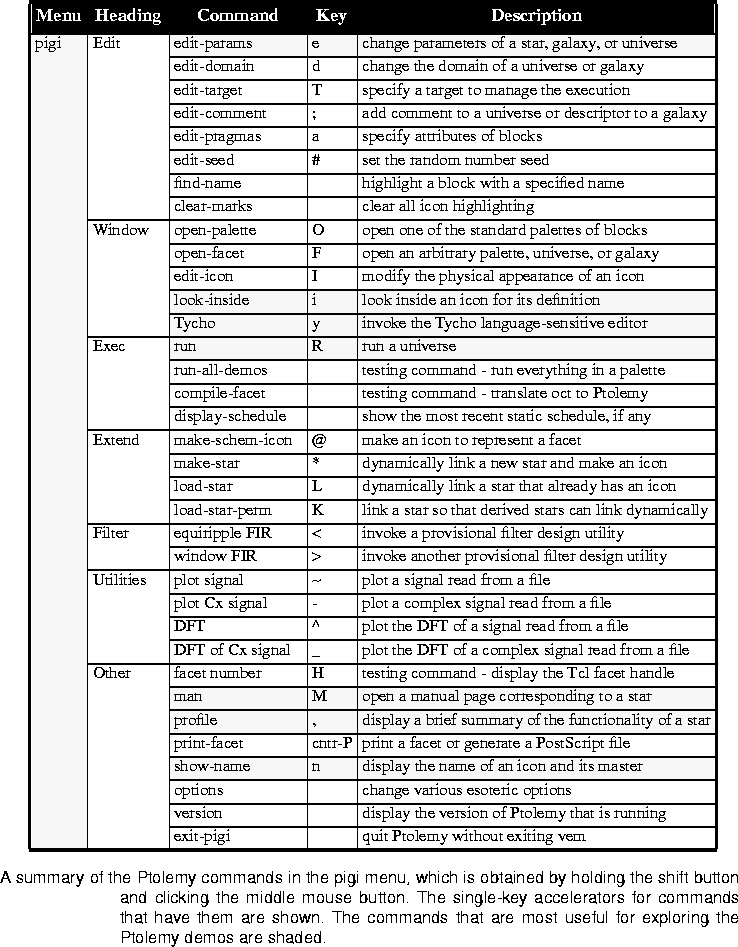 The few commands you will need immediately are shaded in table
2-2.
The few commands you will need immediately are shaded in table
2-2.
Look inside the first demo on the third row, labeled "sinMod". You will see the schematic shown in figure
2-4.
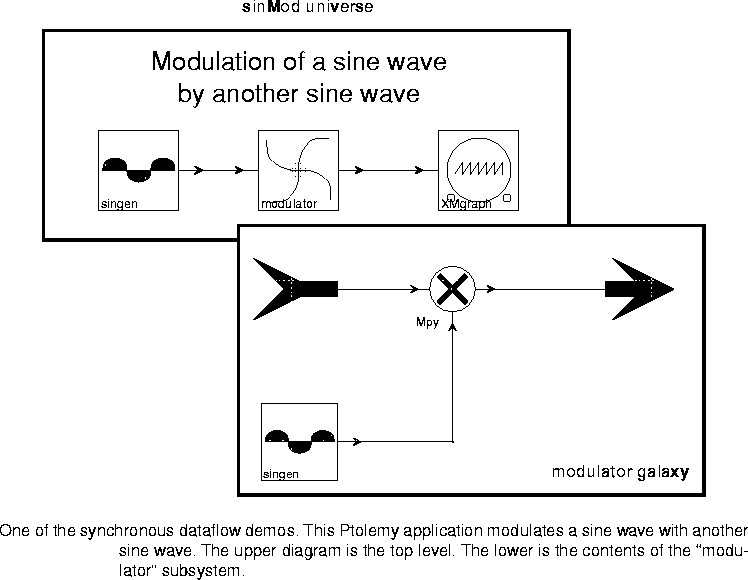 Try looking inside any of the icons in this schematic. If you look inside the icon labeled "modulator", you will see the lower schematic in figure
2-4. If you look inside the icon labeled "XMgraph", this time, instead of graphics, you will see text that defines the functionality of the block. The syntax of this text is explained in the programmer's manual, volume 3 of the Almagest. You can change the editor used to display the text by setting an environment variable
Try looking inside any of the icons in this schematic. If you look inside the icon labeled "modulator", you will see the lower schematic in figure
2-4. If you look inside the icon labeled "XMgraph", this time, instead of graphics, you will see text that defines the functionality of the block. The syntax of this text is explained in the programmer's manual, volume 3 of the Almagest. You can change the editor used to display the text by setting an environment variable PT_DISPLAY (see
"Environment variables" on page 2-61).
To run the sinMod system using the walking menu, place the mouse cursor anywhere in the window containing the sinMod schematic, i.e., your cursor should be in the window that contains the following schematic: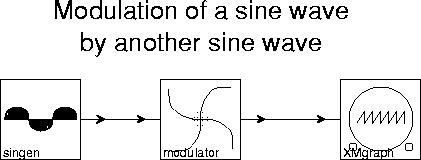
Again holding the shift key, click the middle mouse button. Go to the "Exec" sub-menu, and select "run" by clicking any button. Notice that typing an "R" would have had the same effect. The following control panel pops up: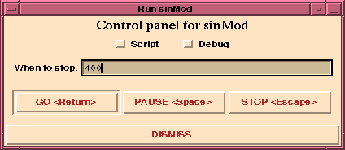
If you click the left mouse button on the "GO" button (or hit "return"), Ptolemy will run this application through 400 iterations. When the run is finished, a graph appears, as shown in figure
2-5.
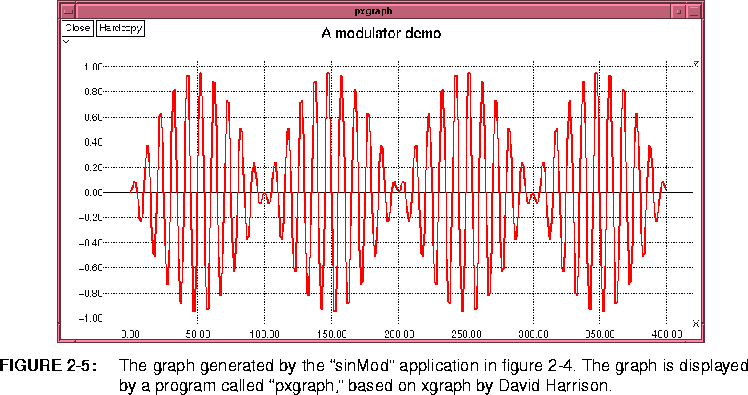 Try resizing and moving this display. Experiment in this
Try resizing and moving this display. Experiment in this pxgraph window by drawing boxes; to draw a box, just drag any mouse button. This causes a new window to open with a display of only the area that your box enclosed. Although the new window covers the old, if you move it out of the way, you can see both at once. Any of the now numerous open windows can be closed with a control-d.
Place the mouse cursor in any schematic or palette window, and click the middle mouse button without holding the shift key. The vem command menu, which is different from the pigi command menu, appears. This menu is the same style of "walking menu" as the pigi menu, and is shown below: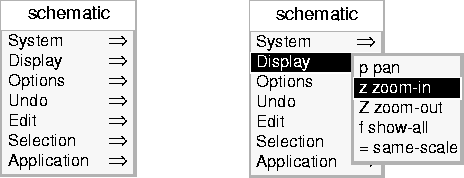
The vem menu is used for manipulating the graphical description of an application. The commands obtained through this menu are summarized in table
2-3, and explained in full detail in The Almagest.
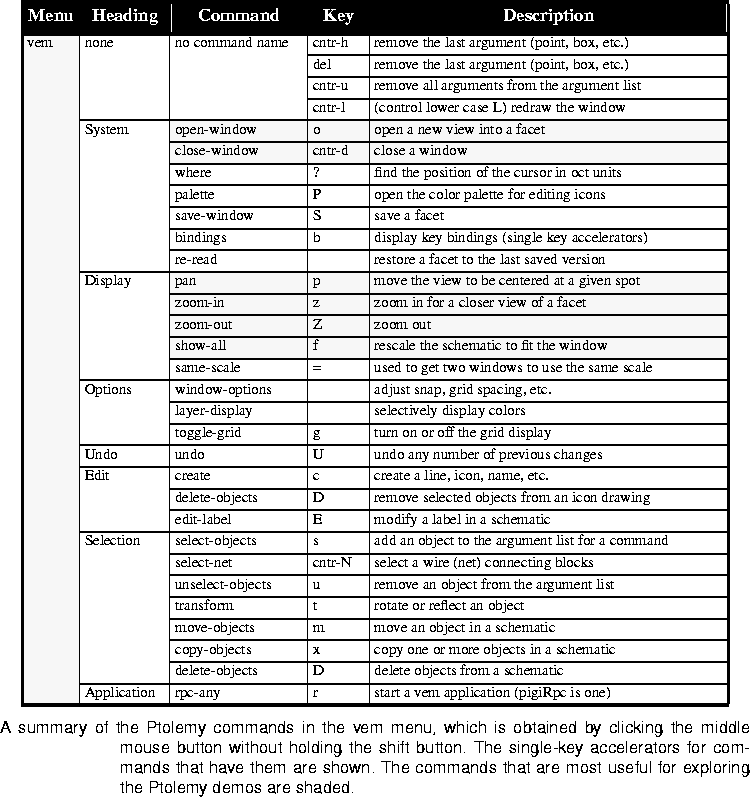
A few additional window manipulations will prove useful almost immediately. In any of the vem windows, you can closely examine any part of the window by drawing a box enclosing the area of interest and typing an "o". Like in a pxgraph window, this causes a newwindow to open, showing only the enclosed area. Unlike pxgraph windows, typing the "o" is necessary. In addition, you can enlarge a window using your window manager manipulation, and type an "f" to fill the window with the schematic. You can also zoom-in (or magnify) by typing a "z", and zoom-out by typing a "Z" (see table
2-3 on page 2-22). These and other vem commands are referenced again later.
You may wish to understand exactly how this sinMod example works. There are several clues to the functionality of the stars. After a while, the icons themselves will be all you will need. At this point, you can get several levels of detail about them. First, you will want to know the name of each star. If you have closed the sinMod window, open it again. Notice the names that appear on each of the icons. In more complicated schematics, when the icons are much smaller, the names will not show. You can zoom-in on a region of the window to see the names. Alternatively, you can place the mouse on any icon and issue the "show-name" command (in the "Other" menu), or type "n".
Find the singen block at the left of the sinMod schematic. To understand its function, place the mouse cursor on it, and execute the Other:profile command. Here "Other" refers to the command category and "profile" to the command in the submenu (you may also type ","). This command invokes a window that summarizes the behavior of the block, as shown below:
For some blocks, further information can be obtained with the Other:man ("M") command, which displays a formatted manual page. This facility, however, currently has many limitations. Try it on the XMgraph block at the right of the schematic. The man command requires that the program xditview be installed and in your path. It also requires a program ditroff. If it fails to find these programs, the manual page will be formatted with nroff and displayed on the standard output, which is considerably less useful. In the next version of Ptolemy, the documentation will be formatted using HTML and displayed on-line. The ultimate documentation for any block is, of course, its source code. For the singen block, the source is another schematic. Use the "look-inside" command (using the accelerator key "i") to see it. Recall that you can also look at the source code of the lowest level blocks (called stars) by looking inside them.
You can safely explore other demos in the palette by the same mechanism. The butterfly demo at the upper left of the "basic" palette in figure
2-3 is particularly worthwhile. The demos in this and other palettes are briefly summarized in
"An overview of SDF demonstrations" on page 3-111.
The init.pal palette in figure
2-1 contains icons leading to a top-level demo directory for each domain distributed with Ptolemy. Some of these are labeled "experimental". These domains largely reflect research in progress and should be viewed as concept demonstrations only. Most will not run under ptiny. The mature domains have no such label, although even these domains contain some experimental work. A quick tour of the basic capabilities can be had by looking inside the icon labeled "quick tour" in the start-up palette shown in figure
2-1. Each time you encounter a universe, run it.
For readers familiar with previous versions of Ptolemy, you may wish to take a tour of the new features only. The "What's New" icon in the init.pal palette in figure
2-1 leads to such a tour. Look inside it and you will see an icon for each of the last several releases. Open any one and explore the icons therein. Each time you encounter a universe, feel free to run it.








Copyright © 1990-1997, University of California. All rights
reserved.




















